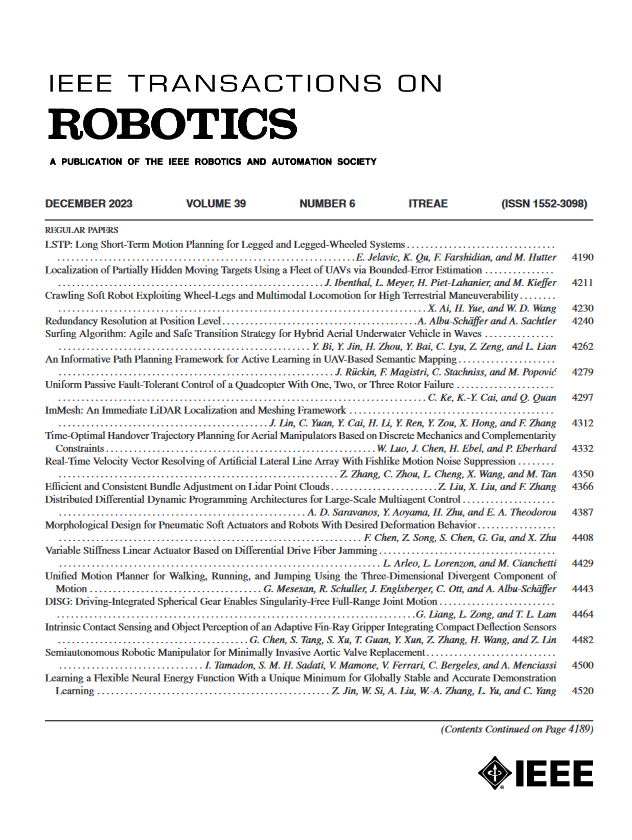iKalibr:弹性集成惯性系统的统一无目标时空校准
IF 10.5
1区 计算机科学
Q1 ROBOTICS
引用次数: 0
摘要
集成惯性系统通常集成了IMU和外部感知传感器,如雷达、光探测和测距(LiDAR)和相机,已被广泛接受并应用于现代机器人应用中,用于自我运动估计、运动控制或自主探索。为了提高系统的准确性、鲁棒性和进一步的可用性,通常将多个和各种传感器弹性集成在一起,这有利于系统在容错、感知能力和环境兼容性方面的性能。对于这样的系统,需要精确和一致的时空校准,以保持多传感器融合的独特时空框架。针对现有标定方法多针对特定集成惯性系统,多侧重于空间确定,多需要人工目标,缺乏便利性和可用性等问题,提出了一种针对弹性集成惯性系统的统一无目标时空标定框架iKalibr,该框架克服了上述问题,实现了标定的准确性和一致性。目前iKalibr总共支持四种常用的传感器,即IMU、雷达、激光雷达和摄像头。该方法首先进行严格、高效的动态初始化,准确恢复估计器中的所有参数。随后,进行了几次连续批优化,以将初始化参数细化到更好的状态。进行了充分的实际实验来验证ialibr的可行性并评估其校准性能。结果表明,iKalibr可以实现精确的弹性时空定标。本文章由计算机程序翻译,如有差异,请以英文原文为准。
iKalibr: Unified Targetless Spatiotemporal Calibration for Resilient Integrated Inertial Systems
The integrated inertial system, typically integrating an IMU and an exteroceptive sensor, such as radar, light detection and ranging (LiDAR), and camera, has been widely accepted and applied in modern robotic applications for ego-motion estimation, motion control, or autonomous exploration. To improve system accuracy, robustness, and further usability, both multiple and various sensors are generally resiliently integrated, which benefits the system performance regarding failure tolerance, perception capability, and environment compatibility. For such systems, accurate and consistent spatiotemporal calibration is required to maintain a unique spatiotemporal framework for multisensor fusion. Considering that most existing calibration methods first, are generally oriented to specific integrated inertial systems, second, often focus on spatial-only determination, and third, usually require artificial targets, lacking convenience and usability, we propose iKalibr: a unified targetless spatiotemporal calibration framework for resilient integrated inertial systems, which overcomes the above issues, and enables both accurate and consistent calibration. Altogether four commonly employed sensors are supported in iKalibr currently, namely, IMU, radar, LiDAR, and camera. The proposed method starts with a rigorous and efficient dynamic initialization, where all parameters in the estimator would be accurately recovered. Subsequently, several continuous-time batch optimizations are conducted to refine the initialized parameters toward better states. Sufficient real-world experiments were conducted to verify the feasibility and evaluate the calibration performance of iKalibr. The results demonstrate that iKalibr can achieve accurate resilient spatiotemporal calibration.
求助全文
通过发布文献求助,成功后即可免费获取论文全文。
去求助
来源期刊

IEEE Transactions on Robotics
工程技术-机器人学
CiteScore
14.90
自引率
5.10%
发文量
259
审稿时长
6.0 months
期刊介绍:
The IEEE Transactions on Robotics (T-RO) is dedicated to publishing fundamental papers covering all facets of robotics, drawing on interdisciplinary approaches from computer science, control systems, electrical engineering, mathematics, mechanical engineering, and beyond. From industrial applications to service and personal assistants, surgical operations to space, underwater, and remote exploration, robots and intelligent machines play pivotal roles across various domains, including entertainment, safety, search and rescue, military applications, agriculture, and intelligent vehicles.
Special emphasis is placed on intelligent machines and systems designed for unstructured environments, where a significant portion of the environment remains unknown and beyond direct sensing or control.
 求助内容:
求助内容: 应助结果提醒方式:
应助结果提醒方式:


